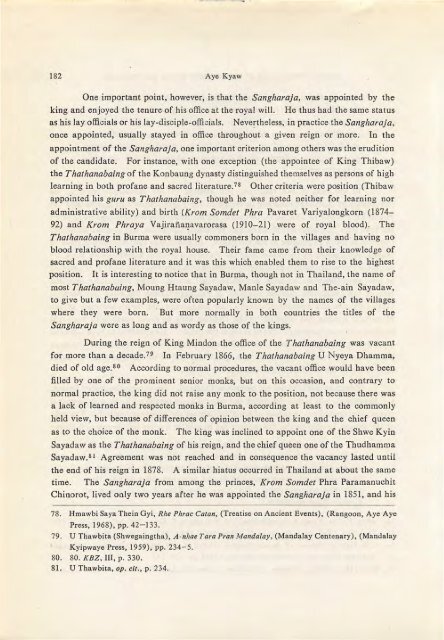The Journal of the Siam Society Vol. LXXII, Part 1-2, 1984 - Khamkoo
The Journal of the Siam Society Vol. LXXII, Part 1-2, 1984 - Khamkoo
The Journal of the Siam Society Vol. LXXII, Part 1-2, 1984 - Khamkoo
You also want an ePaper? Increase the reach of your titles
YUMPU automatically turns print PDFs into web optimized ePapers that Google loves.
182 Aye Kyaw<br />
One important point, however, is that <strong>the</strong> Sangharaja, was appointed by <strong>the</strong><br />
king and enjoyed <strong>the</strong> tenure <strong>of</strong> his <strong>of</strong>fice at <strong>the</strong> royal will. He thus had <strong>the</strong> same status<br />
as his lay <strong>of</strong>ficials or his lay-disciple-<strong>of</strong>ficials. Neve~<strong>the</strong>less, in practice <strong>the</strong> Sangharaja,<br />
once appointed, usually stayed in <strong>of</strong>fice throughout a given reign or more. In <strong>the</strong><br />
appointment <strong>of</strong> <strong>the</strong> Sangharaja, one important criterion among o<strong>the</strong>rs was <strong>the</strong> erudition<br />
<strong>of</strong> <strong>the</strong> candidate. For instance, with one exception (<strong>the</strong> appointee <strong>of</strong> King Thibaw)<br />
<strong>the</strong> Thathanabaing <strong>of</strong> <strong>the</strong> Konbaung dynasty distinguished <strong>the</strong>mselves as persons <strong>of</strong> high<br />
learning in both pr<strong>of</strong>ane and sacred literature.?B O<strong>the</strong>r criteria were position (Thibaw<br />
appointed his guru as Thathanabaing, though he was noted nei<strong>the</strong>r for learning nor<br />
administrative ability) and birth (Krom Somdet Phra Pavaret Variyalongkorn (1874-<br />
92) and Krom Phraya Vajirafiai).avarorasa (1910-21) were <strong>of</strong> royal blood). <strong>The</strong><br />
Thathanabaing in Burma were usually commoners born in <strong>the</strong> villages and having no<br />
blood relationship with <strong>the</strong> royal house. <strong>The</strong>ir fame came from <strong>the</strong>ir knowledge <strong>of</strong><br />
sacred and pr<strong>of</strong>ane literature and it was this which enabled <strong>the</strong>m to rise to <strong>the</strong> highest<br />
posttlon. It is interesting to notice that in Burma, though not in Thailand, <strong>the</strong> name <strong>of</strong><br />
most Thathanabuing, Moung Htaung Sayadaw, Manle Sayadaw and <strong>The</strong>-ain Sayadaw,<br />
to give but a few examples, were <strong>of</strong>ten popularly known by <strong>the</strong> names <strong>of</strong> <strong>the</strong> villages<br />
where <strong>the</strong>y were born. · But more normally in both countries <strong>the</strong> titles <strong>of</strong> <strong>the</strong><br />
Sangharaja were as long and as wordy as those <strong>of</strong> <strong>the</strong> kings.<br />
During <strong>the</strong> reign <strong>of</strong> King Mindon <strong>the</strong> <strong>of</strong>fice <strong>of</strong> <strong>the</strong> Thathanabaing was vacant<br />
for more than a decade,79 In February 1866, <strong>the</strong> Thathanabaing U Nyeya Dhamma,<br />
died <strong>of</strong> old age. 80 According to normal procedures, <strong>the</strong> vacant <strong>of</strong>fice would have been<br />
filled by one <strong>of</strong> <strong>the</strong> prominent senior monks, but on this occasion, and contrary to<br />
normal practice, <strong>the</strong> king did not raise any monk to <strong>the</strong> position, not because <strong>the</strong>re was<br />
a lack <strong>of</strong> learned and respected monks in Burma, according at least to <strong>the</strong> commonly<br />
held view, but because <strong>of</strong> differences <strong>of</strong> opinion between <strong>the</strong> king and <strong>the</strong> chief queen<br />
as to <strong>the</strong> choice <strong>of</strong> <strong>the</strong> monk.<br />
<strong>The</strong> king was inclined to appoint one <strong>of</strong> <strong>the</strong> Shwe Kyin<br />
Sayadaw as <strong>the</strong> Thathanabaing <strong>of</strong> his reign, and <strong>the</strong> chief queen one <strong>of</strong> <strong>the</strong> Thudhamma<br />
Sayadaw.8 1 Agreement was not reached and in consequence <strong>the</strong> vacancy lasted until<br />
<strong>the</strong> end <strong>of</strong> his reign in 1878. A similar hiatus occurred in Thailand at about <strong>the</strong> same<br />
time. <strong>The</strong> Sangharaja from among <strong>the</strong> princes, Krom Somdet Phra Paramanuchit<br />
Chinorot, lived only two years after he was appointed <strong>the</strong> Sangharaja in 1851, and his<br />
78. Hmawbi Saya <strong>The</strong>in Gyi, Rhe Phrac Catan, (Treatise on Ancient Events), (Rangoon, Aye Aye<br />
Press, 1968), pp. 42-133.<br />
79. U Thawbita (Shwegaingtha), A-nhae Tara Pran Mandalay, (Mandalay Centenary), (Mandalay·<br />
Kyipwaye Press, 1959), pp. 234-5.<br />
80. 80. KBZ, III, p. 330.<br />
81. U Thawbita, op. cit., p. 234.

















